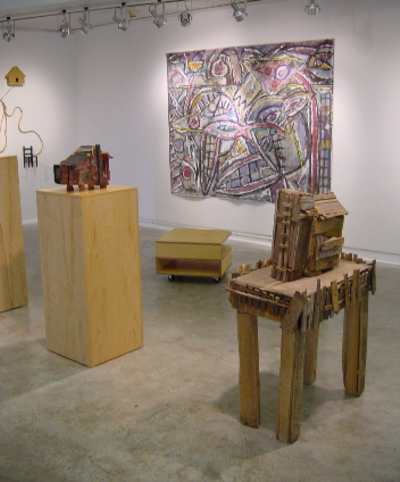>>THAT PLACE, MIA Gallery, July 25 - September 20, 2002<<

We are pleased to present the third and final link to the successful That
Place exhibitions which opened in Miami's Design District in May, 2002.
All three exhibitions feature paintings, photographs, videos and multi-media
works by contemporary
artists from the collections of Rosa and Carlos de la Cruz, Ivelin and Craig
Robins, Debra and Dennis Scholl, Toni and Daniel Holtz, Janet and William Eaglstein
and Juan Lezcano. In this final venue, we also have works from Fredric Snitzer
Gallery and Bernice Steinbaum Gallery, and works by invited artists.
All three components of That Place were curated by Cesar Trasobares,
an artist who defines his practice broadly. In the studio, Cesar produces a
large body
of work in multiple media; in the cultural community, he serves as art activist,
curator, educator, and performer. Involved in a broad, live social/aesthetic
inquiry, he expands the boundaries of what artists do in contemporary society.
He seeks to be an activist for other artists' visions and rights, a cultural
leader concerned about the valuation and uses of art, and a curator entering
into discourse with today's audiences.
The conceptual focus of That Place seeks to stretch our notions of
place through the presentation of contemporary works. Aware that contemporary
art can often
be viewed as inaccessible, the catalogue provides a brief abstract about each
work in the exhibition. Although language has little in common with the "thing" to
which it refers, we hope that the words will help illuminate or clarify the
artists' intentions and thus add to your enjoyment of the work.
Yolanda Sánchez, Director
Airport Fine Arts & Cultural Affairs

Passengers walking through train terminals in the last two centuries often
faced inspiring buildings, academic sculpture and official paintings. Today's
travelers
encounter airports with monumental architecture, lots of gustatory and shopping
options and, occasionally, contemporary art. With the surge of public art programs
in the last three decades, American airports are becoming more significant
cultural settings as well as legitimate venues for the enjoyment of art. In
a site of
passage and transition, this exhibition deals with the subject of places, bringing
the work of talented artists to the broad audiences that pass through MIA.
Contemporary artists everywhere have continued the ancient tradition of imagining,
portraying, simulating and creating places. Artists use both traditional materials
and conceptual approaches in this group of paintings, sculptures, photographs
and installations. Some works present familiar images, while others contain
degrees of abstraction, fantasy, sound and texts. Like speech, art reflecfs
the mechanics
of the human mind.
We manifest and conduct our lives moving among real and imagined places - spaces
to live in groups or alone, areas to hide and to seek, sites within and outside,
physical environments, psychological realms, fabricated contexts, virtual territories,
symbolic destinations. In an era of translation and displacement, one's location
becomes an interesting question.
Dealing with the world around us, we travel among home, cities and countries,
and as we displace our bodies, we move across a spectrum of human customs and
beliefs. Spaces define the persons who use them, frame their actions and context
their activities. Stadiums are for civilized fighting and playing, churches
and synagogues for praying and community building, offices for conducting business
and making deals, homes for living and celebrating, schools for learning and
growing, airports and highways for connecting and running away. Human activities
in all of these places provide fertile subjects for today's artists everywhere.
Connecting most parts of the planet, airports have become villages that mirror
the larger communities outside their runways and terminals, including cultural
processes and populations. The artists in this exhibition give travelers insight
into the nature of places and the expanded territories that constitute the
emerging world of the 21st Century.
César Trasobares
Curator
